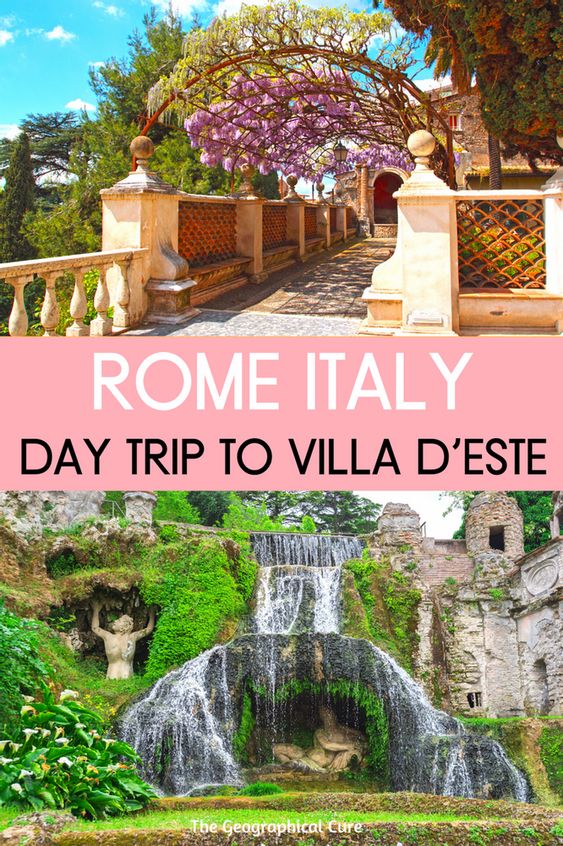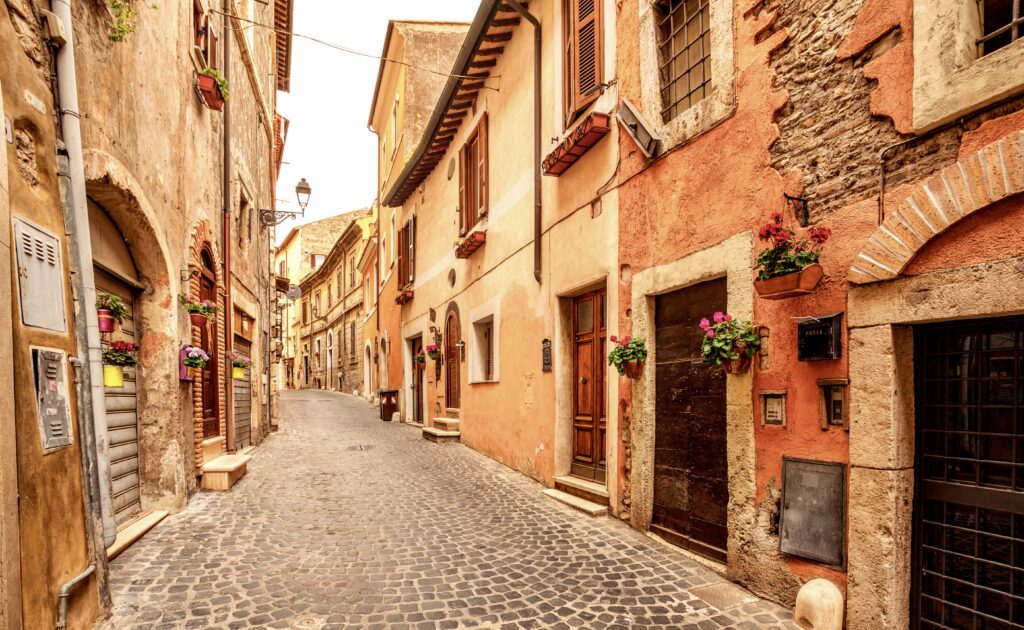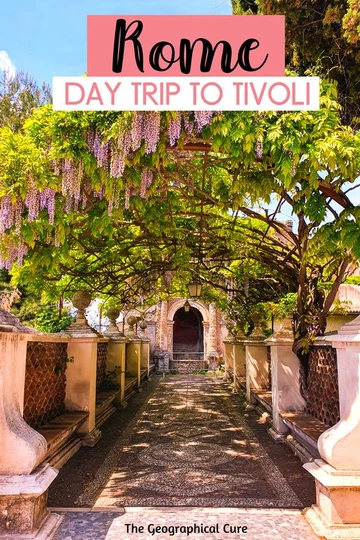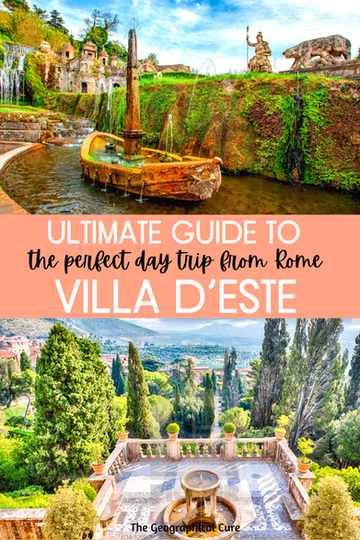Here’s my complete guide to visiting the UNESCO-listed site of Villa d’Este in Tivoli Italy.
Villa d’Este is the lush and watery country estate and gardens of a Catholic cardinal. It makes the perfect day trip escape from Rome, just a half hour away.
The sumptuous late Renaissance estate is reconfigured into a mountainside. It’s a dramatic fusion of architecture and landscape. It’s a playground of whimsy, topped with a frescoed villa.
Built into a cliff, Villa d’Este’s terraced gardens are one of Europe’s most beautiful green spaces.

There are waterfall fountains, ornate staircases, spiky cypress trees. The gentle murmur of water iseverywhere. Statues of ancient deities complete the enchanting tableaux.
If you’ve had your fill of Rome’s urban intensity and adoring tourists, pretty and playful Tivoli is a delicious escape. No other garden has such spectacular waterworks and theatrics.
You can trade the cacophony of Rome for mossy grottos and water lilies. If you have a soft spot for sparkling fountains, Villa d’Este is a must visit town in Italy.
Cardinal Ippolito d’Este
Villa d’Este was the passion project of a cardinal whose papal ambitions were thwarted, Cardinal Ippolito d’Este. Ippolito was born to a wealthy family. As was the case with the Doria Pamphilj family, nepotism was an immense help on the road to success.
Ippolito’s parents were the notorious Lucrezia Borgia (the daughter of the equally notorious Pope Alexander VI) and Alfonso d’Este. He had a fast-tracked ecclesiastic career and became cardinal at age 30.
In 1550, however, the ambitious cardinal’s greatest hopes were dashed when he failed to become pope. As a consolation prize, the conclave winner, Julius III, appointed Ippolito governor of Tivoli. He gifted him a small villa that was a former convent to soothe the cardinal’s disappointment.
But the spartan governor’s palace didn’t suit a man used to luxury who lived like a secular prince.
So Ippolito decided to build a grandiose pleasure palace. He wanted a garden villa worthy of “one of the wealthiest ecclesiastics of the sixteenth century.”
History of Villa d’Este
Ippolito hired the famous architect Pirro Ligorio and a raft of craftsman and painters.
His builders expropriated and tore down part of the former Franciscan monastery to clear the site. They diverted the Aniene River to provide water for the lavish gardens and fountains.
Ippolito decorated the villa with stunning frescos, with religious, mythological, and historical themes.
He created fountains galore — tiny drinking fountains, reflecting pools, and a fountain that played organ music. The stunning result was the world’s most beautiful and most imitated Italian Renaissance garden.
Ippolito’s guests arrive in small carriages, gazing at the magnificent villa from below. They would proceed through the gardens, each terrace revealing a different jardins des merveilles, or garden of miracles. The gardens were used to stage lavish parties.
But part of Villa D’Este’s beauty came at the expense of the nearby Hadrian’s Villa, just 5 minutes away. Ligorio was conveniently excavating Hadrian’s Villa while he worked on Villa d’Este. Ippolito had his architect carry off marble, mosaics, and statuary from the abandoned 1st century villa.

Cardinal Ippolito died in 1572, after being expelled from the church by Pope Paul IV. He was convicted of simony, the white collar sin of lining one’s pockets by selling church roles and sacred relics.
Villa d’Este was bequeathed to the d’Este family. Ippolito’s successors enriched the villa with new fountains, including one by the famous Baroque sculptor, Gianlorenzo Bernini.
It eventually passed into the Hapsburgs’ greedy hands. After the peace treaty of WWI, Villa d’Este became the property of the Italian state.
With enormous upkeep expenses, the villa fell into disrepair. Eventually, it was fully restored, beginning in 1851. In the 1920s, Villa d’Este was opened to the public. In 2001, it became a designated UNESCO site.
Guide To Villa D’Este: What To See
There are so many things to see at Villa d’Este on the palace and garden grounds.
The villa itself is a bit of an empty shell, with the furnishings and decor long gone. But most of the vibrant frescos and painted ceilings remain. (Some were destroyed during WWII.)
The frescos are superb, depicting scenes from Roman history, mythology, and religion. They were painted by the best artists of the late Renaissance and Mannerist period, including Duranti Alberti, Girolamo Muziano, Flaminio Bollinger, Emilio Moretti, and Frederico Zuccari among others.
1. The Upper Palace
You enter the villa via a side entrance. A double stairway leads you to the upper floor. This floor served as the private apartments of Cardinal Ippolito.
The most interesting rooms are the Throne Room, the bedroom, the private study, and the chapel. Another five rooms off to the right complete the upper palace.
2. The Lower Level | Noble Apartment
The lower level served as the guest quarters. The highly decorated rooms are connected by a corridor called the Manica Lunga.
It’s topped with a barrel vault covered with beautiful 16th century 3D mosaics, making it feel like you’re in a rose garden. The rooms on this level are each decorated with a specific theme, connected to nature, mythology, and water.
You enter directly into the most distinguished room, the Central Room, also known as the Hall of the Fountain. The entire vault is decorated with frescos and boasts a beautiful mosaic fountain.
The mosaic fountain is encrusted with pieces of glass, seashells and precious stones, and crowned by the omnipresent white eagle of the d’Este family.
The central painting is based on a Raphael fresco from the Villa Farnesina in Rome’s Trastevere neighborhood. This was the room where Cardinal Ippolito entertained guests or held concerts.
The First Hall is dedicated to the founding of Tivoli, depicting the legendary origins of the town. The Hall of Hercules depicts the labors of Hercules, who was considered the founder of the d’Este family.
The Hall of Moses features a fresco depicting Moses striking a rock to create water for the people of Israel. This was an allusion to the cardinal, who had brought water to the Villa gardens by making channels through the rock.
There are many other rooms. It would take forever to describe them. And the most fabulous part of the tour awaits outside.
3. The Garden and Fountains
Off the Central Room a small loggia offer the first dramatic views of the main event — one of the world’s most beautiful landscaped gardens. They were designed and built by Pirro Ligorio over 17 years.
A double stairway leads you down to this bucolic retreat. Set over 35,000 square meters, it will blow you away.
Try to allot sufficient time so that your visit isn’t rushed. Ideally, you’ll have a leisurely revel amidst the thundering fountains, placid pools, grottos, waterfalls, and natural beauty.
The 50 large fountains and 250 water jets are all gravity powered, a miracle of Renaissance plumbing.
The garden is a combination of terraces and slopes. There’s one central longitudinal axis and five transverse axes.
Paths link the fountains together. The total effect is reminiscent of the beautiful gardens of the Royal Alcazar in Seville.
The central axis leads down to the Bicchierone Fountain. Bicchierone means large drinking glass.
Built in 1661, the monumental stone fountain was designed by legendary Baroque sculptor Gian Lorenzo Bernini. The fine lines of the fountain dramatically represent a chalice held up by a giant seashell.
From the Bicchierone Fountain, turn left and you’ll see the Rometta Fountain. This fountain is a fantastical miniature recreation of important Roman buildings and symbols.
It was designed by architect Ligorio, possibly with assistance from Ippolito. It’s reached by a small bridge spanning a curving canal.
There’s a small scale model of Tiber Island in Rome in the shape of a boat in the basin. At the center of the island is a statue of Victorious Rome, sculpted by Pietro Lamotte, and the Roman She Wolf nursing the twins Romulus and Remus. (The original She Wolf sculpture is in Rome’s Capitoline Museums.)
Some original parts of the Rometta ensemble — including the Colosseum, Pantheon, and Arch of Titus — were demolished by the passage of time.
At the center of the Villa d’Este gardens lies the beautiful Fountain of the Dragons. It’s a true gem incorporating the best of art, architecture, and sculpture.
This fountain was also designed by Ligorio, who created two harmonious staircases to embrace the vivacious fountain. Four moss covered dragons, meant to be frightening, spout rockets of water though open mouths.
The fountain is also known as the Fountain of the Girandola, which means rotating waterworks. Recently restored, the fountain spouts mighty jets of water skyward in a complicated pattern.
Then, stroll along the enchanting Avenue of the Hundred Fountains, which leads from the Rometta Fountain to the Fountain of Ovato. Allegorically, the avenue represents the Aniene River, which runs from Tivoli to Rome.
The path is lined with sculptures gushing and gurgling water. Above them, you’ll see other sculptures of lilies, obelisks, boats, and eagles.
As mentioned above, the eagles belong to the coat of arms of the d’Este family. The marble wall, now corroded by time, was originally carved with episodes from Ovid’s Metamorphoses.
The Fountain of Ovato, or Oval Fountain, is also known as the Fountain of Tivoli. It’s perhaps the loveliest and most elegant fountain at the villa.
This magnificent Baroque fountain takes its name from its oval shape. At the back, a semi circle of pilasters hold bases from which water flows. The statue of Pegasus appears about to soar. You’ll also see the Sibyl of Tibur holding the hand of her son.
The fountain is bordered by a grotto like half moon terrace with a marble balustrade. The water basin below is lined with a semi circulate nymphaeum.
In the niches are statues of nymphs holding vases with flowing water. The bottom of the basin is covered in colorful ceramic lilies and the d’Este coat of arms.
At the end of the lane bordering the fish pond is the Fountain of Neptune, right under the Fountain of the Organ. In terms of impressive water displays, this fountain is likely the grandest in the villa.
And it’s the newest. It was built in the 1920s by Attillio Rossi, then curator of the Villa d’Este.
Twelve strong jets hurl water skyward at different heights, some reaching 45 feet. The lower basin calms the frothy waters to suit the adjacent fish ponds.
In the middle, there’s a bust of Neptune. But it’s hard to actually see the bust with the veils of water and mist.
Then, walk up the stairs to inspect the amazing Fountain of the Organ, a stunning engineering achievement created by Frenchmen Claude Venard. The fountain has a hydraulic system consisting of 144 pipes controlled by a water powered pin roller.
This water driven mechanism recreated the sounds of an organ. Legend holds that, when Pope Gregory XII visited the villa, he couldn’t believe his ears. He insisted on a tour of the fountain interior to ensure there weren’t musicians inside.
As befitting its Baroque era creation, the facade is extravagantly decorated. You’ll see seashells, coats of arms, stucco panels depicting mythological themes, winged victories, etc. A d’Este eagle with outstretched wings is perched at the top of the tympanum.
In 2003, the fountain was repaired and its ability to play “music” restored. Now, it plays for four minutes every two hours.
As you stroll through the rest of bucolic gardens, you’ll come on other interesting fountains, gargoyles, and grottos. There are plenty of nooks and crannies to explore.
I was quite taken with the Fountain of Diana of Ephesus. Diana is the goddess of wood and wildlife and protector of women. The many breasts are a symbol of fertility and childbirth.
The Grotto of Diana is also quite lovely. Four statues once adorned the cave — 2 amazons, Minerva, and Diana. They were subsequently acquired by Pope Gregory XIII, who then donated them to the Capitoline Museums in Rome.
The Mete fountains are also in the lower garden, in the middle of two flower beds. They are large circular boulders one atop another covered with moss. They are a symbol of the sweating cone fountain in Rome, which sweated rather than jetted water.
Practical Guide & Tips for Visiting Villa d’Este
Address: Piazza Trento 5, Tivoli, Italy
How to get to Villa d’Este:
It’s an easy 30 minute drive by car. By train, catch a direct train on the Roma-Pescara Line from Rome’s Tiburtina station to Tivoli. It takes about a half hour.
Then, you take a shuttle bus to the town center. Signs point you to the entrance on Piazza Trento. There’s a local bus that shuttles between Villa d’Este and Hadian’s Villa. If you don’t want to arrange your own transport, the easiest thing to do is book a guided day tour.
Hours: Open Tues through Sun 9:00 am to 1 hour before sunset. Since hours vary by season, be sure to check the website when planning your day trip.
Enty fee: 13 euros. Click here to book a skip the line ticket.
When Is the Best Time To Go: Spring is the prettiest time to visit Villa d’Este. You’ll be wowed by the wisteria and jacaranda blooming. But fall is pretty too, with showy yellow and red colors.
Pro tip: Be forewarned, there’s a lot of steep stairs to climb up and down. Plan on spending half a day here, taking in all the delights without rushing.
I hope you’ve enjoyed my guide to Villa d’Este. If you’re planning a trip top Rome, you may enjoy these other Rome travel guides:
- 8 ways to spend 1 day in Rome
- 3 day itinerary for Rome
- 5 day itinerary for Rome
- Hidden gems in Rome
- Best museums in Rome
- Archaeological sites in Rome
- Guide to the Borghese Gallery
- Guide to Palatine Hill
- Guide to the Roman Forum
- Guide to the Colosseum
- Walking tour of central Rome
If you’d like to visit Villa d’Este in Tivoli, pin it for later.


